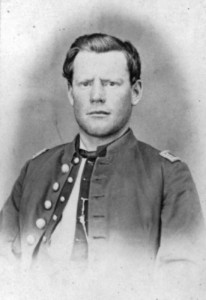“Man’s inhumanity to man makes countless thousands mourn”
Robert Burns, Man was made to mourn: A Dirge (1784)

A monument sits on an overlook that greets visitors of the Sand Creek Massacre National Historic site near Eads, Colorado. In November of 1864, Colorado militiamen killed over 150 Cheyenne and Arapaho Indians on the site who were living peacefully along the creek in their village. (Andy Cross/The Denver Post)
This weekend marks the 150th anniversary of one of the most ruthless and unnecessary “battles” in American history, when 675 Colorado militia slaughtered between 150 and 200 Cheyenne and Arapaho, who were doing just as they were told: flying the Stars and Stripes to indicate their willingness to maintain peace on a scrap of land at the edge of a reservation. Sand Creek is one of many reminders that the American Civil War featured not one, but two sets of dispossessed peoples: Negro slaves and indigenous Americans. The sad part is the latter were largely forgotten for decades afterwards.
Under the leadership of Col. John Chivington, the cavalry functioned like a street gang that morning, descending upon the unarmed villagers at dawn on 29 November, 1864, gunning down women, children and the elderly, execution-style, while able-bodied tribesmen scrambled to find weapons they could use. Militiamen cut off heads, scalps, limbs and genitalia, and later paraded them in the streets of Denver as trophies.
Fortunately, there were some US cavalrymen who were still in possession of their humanity, and refused to attack. One man in particular, Capt. Silas Soule, dared to expose the horrific crimes perpetrated by the soldiers against largely defenseless victims by writing official letters decrying the military’s behavior. As a result, Chivington and Colorado Governor John Evans were forced to resign, but neither was ever tried for his role in the massacre.
Tragically, Captain Soule was himself murdered on a Denver street after the war, and while his assailants were known, they were never tried. Still, in a twist of righteous fate, Soule had the last word, many years after his death.
In 2000, the only first-person accounts of what really happened at Sand Creek were unearthed. In the form of two letters, written in sickening, gruesome detail, the tale was finally and painfully brought into full focus from the 135-year-old voices of Soule and his compatriot, Joe Cramer. The discovery of these letters, among other issues, impelled the Sand Creek historical commission in Colorado to reformulate its take on what happened, and indeed, to make things right.
I won’t expound today on the ocean-deep inequity shoved upon Native Americans as a result of the horror that lay at the heart of Manifest Destiny. Rather, I will hold out hope for our nation to be increasingly compassionate, forward-thinking and colorblind, so 150 years from now, our descendants will look upon eerily similar events of today with the same incredulous repugnance we experienced upon reading those letters, knowing that the country had finally learned its lesson.
A blessed, relaxing Sunday to you!




 Beginning to what? Look a lot like Christmas? Yep.
Beginning to what? Look a lot like Christmas? Yep.